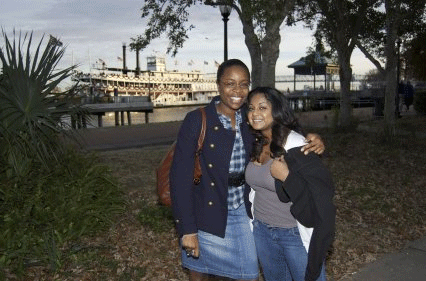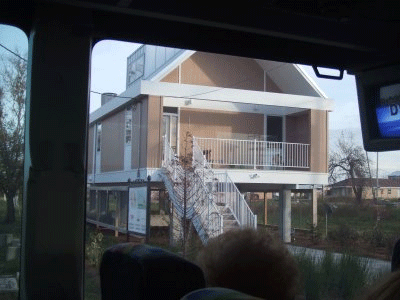Last night we arrived in New Orelans, where we were welcomed into the home of the Gourriers, parents of our student Jared. The Gourriers served up a spectacular meal of crawfish pasta, gumbo, rice and beans, and fried chicken, and after two weeks on the road, we all reveled in the warmth of a real home. This morning we had a rare few hours off, so joined by Prof. Ken Aslakson, a group of us headed to Cafe du Monde for beignets and coffee, then explored Jackson Square, St. Louis Cathedral, and the Mississippi riverfront.

The afternoon was more somber: having acknowledged the triumphs of the Civil Rights movement, we wanted to think deeply about its limits, so we set off on a tour of the damage done by Hurricane Katrina. Though we all agreed that our tour guide tried hard to whitewash the severity of the social injustices that the disaster of Katrina represented, our tour through the lower ninth ward spoke for itself. The devastation that remains is heartbreaking: those who rebuild too often find themselves living amidst houses still bearing the marks of the flood and the symbols of the belated search and rescue effort.
We also drove by a few of the houses that Brad Pitt’s “Make it Right” Foundation has sponsored and the memorial erected to those lost in the flood. The bars symbolize the level the water reached; the empty chairs to the right, those who lost their lives
After our tour, the students met to begin strategizing ways that they could effect change in their world.
Student Responses:
Peter: We are visiting New Orleans to connect the Civil Rights Movement to the present and think about how race and politics played a major role in the aftermath of Hurricane Katrina. Today we took a guided bus tour of the city and got to see a lot of the damage that was done by the storm 4 years ago. When the tour first started, the bus driver/ tour guide made an off-the-cuff comment about why people would want to see the damage. Although he probably shouldn’t have said that to paying customers, I understand that having to relive the memory of Katrina everyday is a difficult thing for someone that Katrina affected so much. While on the tour we passed by houses and spaces in the city with serious damage still left: roofs with holes, deserted golf courses, leveled houses, and trailers on front lawns still remain in the city. It was by no means easy to see. Then the tour went through the lower 9th Ward, the area probably most devastated by the storm. It was horrible what the storm did to these houses and the lives of the people it took and affected. It’s hard to imagine this being a reality, but it was and still is a reality for anyone associated with New Orleans in any capacity.
For me today, one of the most difficult things to grasp is the fact that the government did not use all its resources to help the victims of the storm and the fact today that the insurance companies are still not willing to dish out the money that they owe to these people. It’s sad to see that a dollar amount has been placed on human life. Clearly, this country has a ways to go before we get it right.
On a more positive note, it was great to see that the power of people is still strong because a lot of the work done on homes and the donations made to various causes to help after the storm were contributed from individual private citizens and that was a great thing to see.
Liz: We went on a bus tour of the damage done by Hurricane Katrina. The bus driver was quite interesting: he stated that he did not “understand why people are still interested” in this event. Although he was a native of New Orleans, he failed to realize that, as Americans, we should all learn from this event and make changes-not only the government. He failed to realize that not everyone on the bus was a spectator, but maybe an individual coming to terms with the reality in our country that we’ve heard so much about. He failed to realize that maybe someone on this tour, like me, could be encouraged to come and help this city.
New Orleans was one of my favorite places to go on this whole trip. I am so encouraged to come back and help out the people. This city has everything from culture to amazing food….but it also exemplifies the failures of government to realize the need in our own country. Because of this trip, I am so encouraged to bridge the gaps left open by blind eyes. Until we begin to close the gaps in our country then we cannot move on to become the powerful nation we strive to be.









